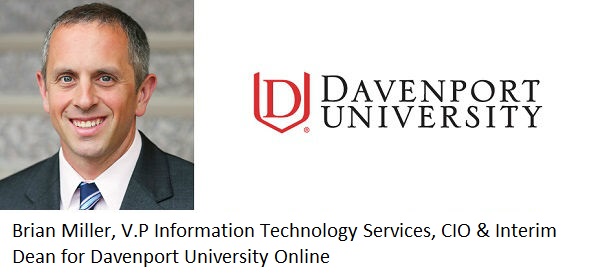
Online education can conjure a range of emotions, depending on who you talk to. For some, attending class online appears to lack face-to-face collaboration with other students and teachers. For others, online classes offer a way to get university-level instruction that wouldn’t be possible otherwise. Students with full-time jobs or a family to take care of simply don’t have the time or finances to spend all day hanging around a college campus. For these students, the benefits of an online degree are clear. Taking classes online, from a distance, and on their own time enables them to pursue something previously impossible to attain: a college education.
As with on-campus learning, distance learning has its own advantages and disadvantages. Without a good understanding of what to expect, students can find themselves lost or frustrated. To get a fuller view of how to handle online learning, I turned to Brian Miller, Interim Dean for Davenport University Online.
What are the biggest advantages of online classes? How do you work with students to overcome the challenges inherent in distance learning?
Miller: The biggest advantage of online classes is the ability to learn from anywhere. For real-time classes, this means we can have one instructor serve students at multiple locations. For your-time classes (classes students take at their own speed) the added benefit of being able to conduct learning on a schedule that’s convenient for students is another huge benefit. In all of our online courses at Davenport, benefits go far beyond flexibility, however. Assignments that get students out into the community with their smartphones, for example, allow us to enhance every student’s experience by combining a diverse set of viewpoints into the online classroom.
The biggest challenges inherent in distance learning revolve around student/professor interaction. Davenport encourages the use of video, the blending of real-time and your-time communication within classes, and the availability of student support services for all of our online learners to ensure that online students have an experience that is on par (or even better!) than our in-seat student experience. The data suggests we have been successful as student retention and satisfaction scores for our Global Campus is nearly identical to our in-seat students.
Brian brings up a couple good points. As already mentioned, the biggest advantages of online learning revolve around flexibility for students. Davenport offers their online classes as either real-time or your-time formats with the ability to make classes fit your schedule. Although interaction with the instructor and other students is sometimes a challenge, it apparently hasn’t been affecting student success.
How different are the online and offline versions of a class? How do you incorporate or work around hands-on demonstrations?
Miller: Davenport operates from a philosophy that the learning outcomes should be the same for both in-seat and online classes. Many times, this means the assignments can be the same as well, but there are clearly cases where the unique nature of the online learning experience requires some changes to how a course may function (so while the overall structure of the course will be the same, some assignments may vary). Hands-on demonstrations may be replaced by recorded video demonstrations. Labs may be replaced by virtual labs or online simulations.
On the other hand, classes where students are all confined to a single location have limitations as well. For example, a global project management class with students located outside the U.S. provides an ideal opportunity to compare best practices from other nations, and a Healthcare MBA course with students in multiple states provides a great opportunity to compare regulations and policies from state to state, using real-world student experiences.
Davenport uses a standardized course development process that ensures consistent learning objectives, textbook selection and assignments (where possible), regardless of delivery modality. While there are differences, this process minimizes the differences where possible.
So basically, the online and in-seat versions of a class are nearly identical except for certain exercises that absolutely won’t work both ways. In Davenport’s case, at least, students learning from afar have nearly the same experience as students on campus. In some cases, having classmates spread across the country or world can even be an advantage.
What online programs have enjoyed the best student outcomes?
Miller: Our online student outcomes are consistent with our in-seat student outcomes. We carefully assess student success for all programs, regardless of delivery. We also have a significant portion of students who take portions of programs online. For that reason, we assess outcomes course-by-course, looking for strengths and weaknesses at that level. Students are free to switch between delivery modes (e.g. online, blended, in-seat) from semester to semester.
That’s good news. MOOCs — massive open online courses — are often associated with abysmal completion rates. This unfairly reflects on online education as a whole. According to Brian, Davenport University suffers no such penalty to student success if a class is taken online, on campus, or as a mix. When I asked if there were any outliers, any classes that simply didn’t work in an online format, his answer was simply, “No, there are not.”
Distance learning has inherent challenges, but so does all learning. Classroom interaction is a hurdle to overcome, but the flexibility offered by online classes is hard to beat. Online education carries a value that in-class learning can’t duplicate, and vice versa. What’s important is identifying your own needs so that you can make the best decisions for your own education.

